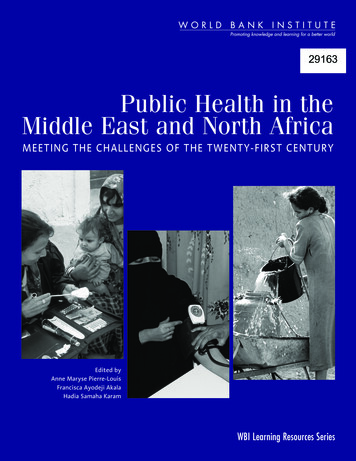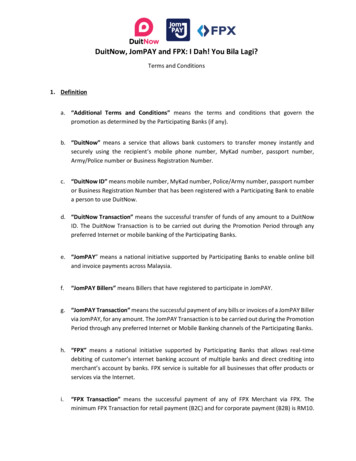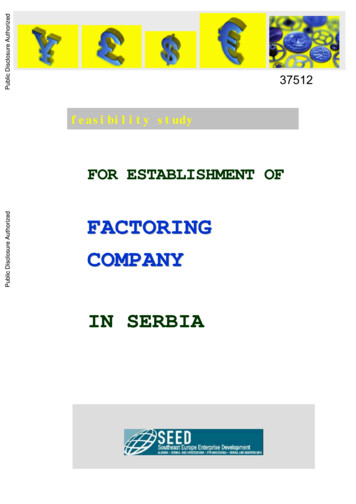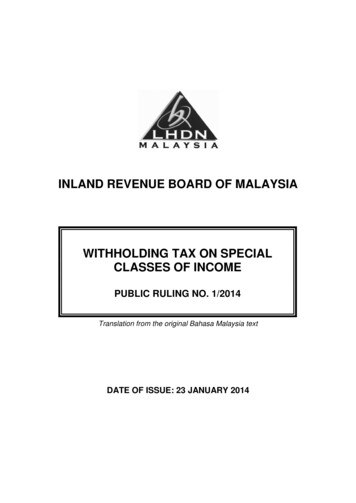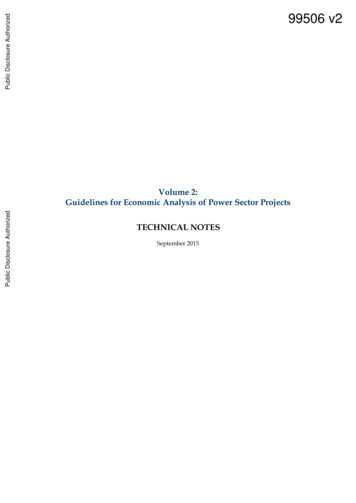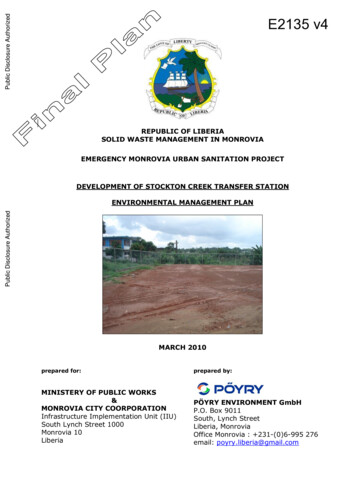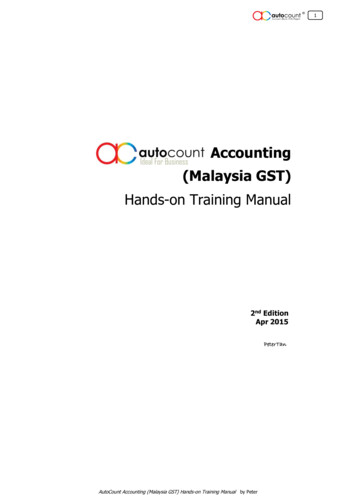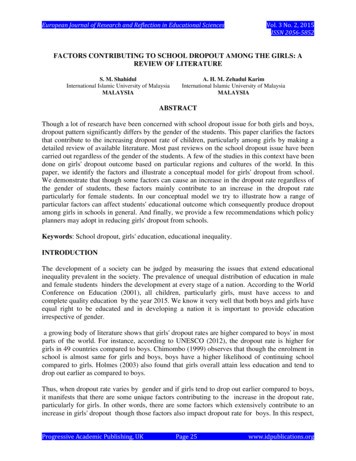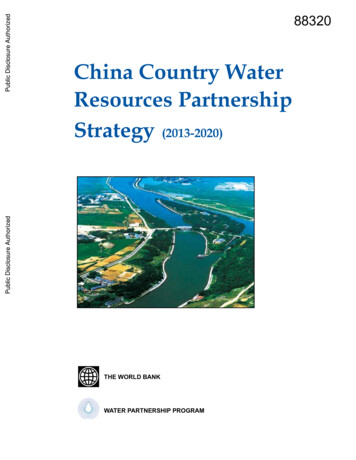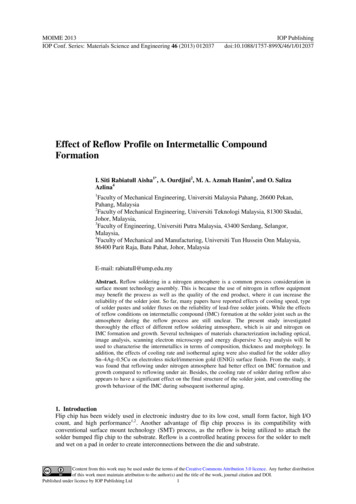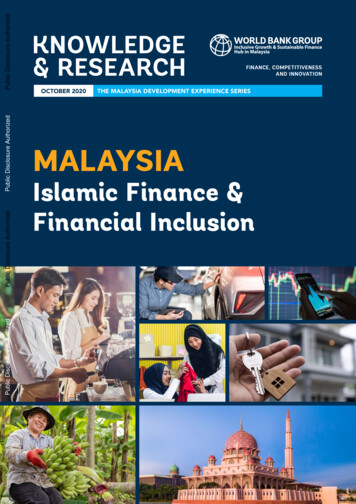
Transcription
Public Disclosure AuthorizedPublic Disclosure AuthorizedPublic Disclosure AuthorizedPublic Disclosure AuthorizedFINANCE, COMPETITIVENESSAND INNOVATIONOCTOBER 2020THE MALAYSIA DEVELOPMENT EXPERIENCE SERIESMALAYSIAIslamic Finance &Financial Inclusion
CONNECT WITH USwbg.org/Malaysia@WorldBankMalaysia@WB AsiaPacifichttp://bit.ly/WB blogsMY
Disclaimer 2020 International Bank for Reconstruction and Development / The World BankSasana Kijang, 2 Jalan Dato Onn, Kuala Lumpur 50480, MalaysiaSome rights reserved.This work is a product of the staff of The World Bank with external contributions. Thefindings, interpretations, and conclusions expressed in this work do not necessarily reflectthe views of The World Bank, its Board of Executive Directors, or the governments theyrepresent. The World Bank does not guarantee the accuracy of the data included in thiswork. The boundaries, colors, denominations, and other information shown on any map inthis work do not imply any judgment on the part of The World Bank concerning the legalstatus of any territory or the endorsement or acceptance of such boundaries.Nothing herein shall constitute or be considered to be a limitation upon or waiver of theprivileges and immunities of The World Bank, all of which are specifically reserved.Rights and PermissionsThis work is available under the Creative Commons Attribution 3.0 IGO license (CC BY3.0 IGO) http://creativecommons.org/licenses/by/3.0/igo. Under the Creative CommonsAttribution license, you are free to copy, distribute, transmit, and adapt this work, includingfor commercial purposes, under the following conditions:Attribution: Please cite the work as follows: World Bank (2020) “Malaysia Islamic Financeand Financial Inclusion” (October), World Bank, Washington, DC.Translations: If you create a translation of this work, please add the following disclaimeralong with the attribution: This translation was not created by The World Bank and shouldnot be considered an official World Bank translation. The World Bank shall not be liable forany content or error in this translation.Adaptations: If you create an adaptation of this work, please add the following disclaimeralong with the attribution: This is an adaptation of an original work by The World Bank.Views and opinions expressed in the adaptation are the sole responsibility of the author orauthors of the adaptation and are not endorsed by The World Bank.Third-party content: The World Bank does not necessarily own each component of thecontent contained within the work. The World Bank therefore does not warrant that theuse of any third-party-owned individual component or part contained in the work willnot infringe on the rights of those third parties. The risk of claims resulting from suchinfringement rests solely with you. If you wish to re-use a component of the work, it is yourresponsibility to determine whether permission is needed for that re-use and to obtainpermission from the copyright owner. Examples of components can include, but are notlimited to, tables, figures, or images.All queries on rights and licenses should be addressed to World Bank Publications,The World Bank, 1818 H Street NW, Washington, DC 20433, USA; e-mail: pubrights@worldbank.org.
OCTOBER 2020THE MALAYSIA DEVELOPMENT EXPERIENCE SERIESMALAYSIAIslamic Finance &Financial Inclusion
AcknowledgementsThis report on “Islamic Finance and Financial Inclusion in Malaysia” was prepared bya World Bank team consisting of Abayomi A. Alawode, (task team leader), Aamir A.Rehman, Ahmad Hafiz Bin Abdul Aziz, Mohamed Eskandar Shah Bin Mohd Rasid andYavar Moini. Other colleagues, including Mohamed Rozani bin Mohamed Osman, RekhaReddy and Wei Zhang provided useful inputs. Joshua Foong and Min Hui Lee providedexcellent editorial assistance. The team worked under the overall guidance of HassanZaman, Cecile Thioro Niang, Irina Astrakhan and Firas Raad.4Malaysia Islamic Finance & Financial Inclusion
Table of ContentsGLOSSARY.8Executive Summary.14CHAPTER 1Evolution of Islamic Financial Inclusion in Malaysia.181.1 Overview and Introduction.191.2 Malaysia as a Leader in Financial Inclusion.211.2.1 Malaysia and ASEAN Members.241.2.2 Malaysia and OIC Members.251.2.3 Malaysia and Upper Middle-Income Countries.271.2.4 Additional Data on Malaysia.291.3 Malaysia as a Global Leader in Islamic Finance.301.3.1 Quantitative Measures of Malaysia’s Islamic Finance Leadership.321.3.2 Qualitative Measures of Malaysia’s Islamic Finance Leadership.331.4 The Role of Islamic Finance in Promoting Financial Inclusion.361.4.1 Removal of Religious Barriers.361.4.2 Sharing of Risk.391.4.3 Social Finance.401.5 Barriers to Financial Inclusion.411.5.1 Barriers in Malaysia and ASEAN Members.411.5.2 Barriers in Malaysia and OIC Members.431.6 Recommendations for Further Research.451.7 Conclusion: Linking Islamic Finance and Financial Inclusion in Malaysia.47CHAPTER 2Regulatory Foundations for Islamic Financial Inclusion.482.1 Overview.492.2 Malaysian Islamic Finance Regulatory Structures.502.3 Malaysia’s Financial Inclusion Framework.52Malaysia Islamic Finance & Financial Inclusion5
2.4 Key Institutional Financial Inclusion Initiatives.542.4.1 BNM. 542.4.2 SC.572.4.3 Bursa Malaysia.572.5 Islamic Social Finance and Financial Inclusion.582.5.1 Zakat.582.5.2 Waqf.592.6 Regulatory Framework for Islamic Social Finance in Malaysia.602.7 Conclusion.61CHAPTER 3Institutional Enablers of Islamic Financial Inclusion.623.1 Role of State in Promoting Inclusion.633.2 Religion as an Incentive to Save.633.3 Affirmative Action for Bumiputeras.643.4 Key Institution Building Under the NEP.643.5 Introduction of Shari’ah Compliant Banking.653.6 Other Initiatives to Increase Financial Inclusion.653.7 Initiatives by BNM – Developing Institutions and Islamic Finance.663.8 Role of Prominent Institutions.673.8.1 TH.673.8.1.1 TH Financial Performance.683.8.1.2 Furthering Financial Inclusion and Islamic Finance.693.8.2 PNB.703.8.2.1 PNB Financial Performance and Products.703.8.2.2 Social Development Programs of PNB.713.8.3 FELDA.723.8.4 Malaysia Co-operative Societies Commission.723.9 Innovative Solutions in Promoting Financial Inclusion.733.10 Islamic Social Finance Institutions.743.10.1 Zakat.743.10.2 Waqf.773.11 Conclusion.786Malaysia Islamic Finance & Financial Inclusion
CHAPTER 4Consumer and Investor Protection in Islamic Finance.804.1 Introduction.814.2 IFSB.834.3 BNM.854.4 SC.874.5 FEN.874.6 IFSA 2013.894.7 Consumer Protection in BNM’s Takaful Regulatory Framework.914.8 Dispute Support/Grievance Recourse.924.9 Conclusion.97CHAPTER 5Broadening Access and Resilience in Digital Islamic Finance: Opportunities and Challenges.985.1 Introduction.995.2 Leveraging Technology in Promoting Financial Inclusion.1015.3 Government Initiatives to Promote the IDE.1035.3.1 Challenges to IDE Growth.1055.4 The Advantages of Digitization.1055.5 Using Digitization to Improve Financial Inclusion.1065.6 Selected FinTech Success Stories (Private and Public Sectors).1075.7 Areas for Further Consideration.1085.8 Expanding Islamic Social Finance Through FinTech.1095.9 Advancing Financial Literacy and Technology.1095.10 Conclusion.110CHAPTER 6Conclusions and Recommendations.1126.1 Islamic Finance and Financial Inclusion.1136.2 Robust Regulatory Support.1136.3 Strong Institutional Enablers.1146.4 Consumer Protection.1156.5 Digitalization and Islamic FinTech.116BIBLIOGRAPHY.117Malaysia Islamic Finance & Financial Inclusion7
GlossaryGLOSSARY8AAOIFIAccounting and Auditing Organization for Islamic Financial InstitutionsACE MarketAccess, Certainty, Efficiency marketAFIAlliance of Financial InclusionAIBIMAssociation of Islamic Bank MalaysiaAIMAmanah Ikthiar MalaysiaAKPKCredit Counseling and Debt Management AgencyASBAmanah Saham BumiputeraASEANAssociation of Southeast Asian NationsASMAmanah Saham MalaysiaASNAmanah Saham NasionalATMsAutomated Teller MachinesAUMsAssets Under ManagementBCCILABasic Certificate Course in Insurance Loss AdjustingBIMBBank Islam Malaysia BerhadBMMBBank Muamalat Malaysia BerhadBNMBank Negara MalaysiaBSCBalanced Score CardBSNBank Simpanan NasionalB2BBusiness to businessCAGRCompound Annual Growth RateCBACentral Bank of Malaysia ActCCRISCentral Credit Reference Information SystemCGCCredit Guarantee CorporationCIMBCommerce International Merchant BankersCMSACapital Markets and Services ActCMSLCapital Markets and Services LicenseCPAConsumer Protection ActCSCCustomer Service CharterCSRCorporate Social ResponsibilityCUREConsumer Complaints RedressDFIADevelopment Financial Institution ActMalaysia Islamic Finance & Financial Inclusion
GlossaryDFIsDevelopment Financial InstitutionsDFSDigital Financial ServicesDIMDigital Investment ManagementDOSMDepartment of Statistics MalaysiaECFEquity CrowdfundingEPFEmployees Provident FundFARFinancial Adviser’s RepresentativeFASFinancial Accounting StandardsFCIFinancial Capability and InclusionFDIForeign Direct InvestmentFELDAFederal Land Development AuthorityFENFinancial Education NetworkFMBFinancial Mediation BureauFSAFinancial Service AuthorityFSBPFinancial Sector BlueprintFSPsFinancial Services ProvidersFTEGFinancial Technology Enabler GroupGDPGross Domestic ProductGLICsGovernment Linked Investment CompaniesGNPGross National ProductHITeCHalal Innovation and Technology CentreIAHsInvestment Account HoldersIAPInvestment Account PlatformICDIslamic Corporation for the Development of the Private SectorICMIslamic Capital MarketICTFInteroperable Credit Transfer FrameworkIDEIslamic Digital EconomyIFDIIslamic Financial Development IndicatorIFDRIslamic Finance Development ReportIFIsIslamic Financial InstitutionsIFRSInternational Financial Reporting StandardsMalaysia Islamic Finance & Financial Inclusion9
Glossary10IFSAIslamic Financial Services ActIFSBIslamic Financial Services BoardIFSISRIslamic Financial Services Industry Stability ReportIOSCOInternational Organization of Securities CommissionsISEASInstitute of Southeast Asian StudiesISFIslamic Social FinanceISRAInternational Shari’ah Research Academy for Islamic FinanceJAKIMDepartment of Islamic Development MalaysiaJAWHARDepartment of Awqaf, Zakat and HajjKFHKuwait Finance HouseKPIsKey Performance IndicatorsLabuan FSALabuan Financial Services AuthorityLEAPLeading Entrepreneur Accelerator PlatformLIWFLabuan International Waqf FoundationLTHLembaga Tabung HajiLZNKLembaga Zakat Negeri KedahMAIDAMCouncil of Islamic Religion and Malay Customs TerengganuMAIWPWilayah Persekutuan Islamic Religious CouncilMDECMalaysia Digital Economy CorporationMESDAQMalaysian Exchange of Securities Dealing and Automated QuotationMIBMaybank Islamic BerhadMIIMalaysian Insurance InstituteMOEMinistry of EducationMOFMinistry of FinanceMSMEsMicro Small Medium EnterprisesMTDCMalaysian Technology Development CorporationMyKNPFinancing Advisory ServicesNBFINon-Banking Financial InstitutionNECNational Economic CouncilNEPNew Economic PolicyNGOsNon-Governmental OrganizationsOFSOmbudsman for Financial ServicesMalaysia Islamic Finance & Financial Inclusion
GlossaryOICOrganisation of Islamic CooperationP2PPeer-to-peer lendingPDPAPersonal Data Protection ActPFIsParticipating Financial InstitutionsPHBPermodalan Hartanah BerhadPIDMMalaysia Deposit Insurance CorporationPNBPermodalan Nasional BerhadPRSPrivate Retirement SchemesPSIAsProfit and loss sharing investment accountsRHBRashid Husain BankRMRinggit MalaysiaSACShari’ah Advisory CouncilSACCOsSavings and Credit CooperativesSCSecurities Commission MalaysiaSDGSustainable Development GoalSGFShari’ah Governance FrameworkSIDRECSecurities Industry Dispute Resolution CenterSIRCsState Islamic Religious CouncilsSMEsSmall Medium EnterprisesSMSShort Message ServiceSRISustainable and Responsible InvestmentTEKUNNational Entrepreneurs GroupTHTabung HajiTOFTakaful Operator FrameworkUNCDFUnited Nations Capital Development FundUNDPUnited Nation Development ProgrammeUNHCRUN High Commissioner for RefugeesUSDUnited States DollarVBIValue-Based IntermediationYaPEIMYayasan Pembangunan Ekonomi Islam MalaysiaYUMYayasan Usaha MajuYWMYayasan Wakaf MalaysiaMalaysia Islamic Finance & Financial Inclusion11
GlossaryGLOSSARY OF ISLAMIC FINANCE TERMSPrinciples of Islamic FinanceProhibition of interest (Riba): The premium (interest) that must be paid by the borrower to thelender along with the principal amount as a condition for the loan or for an extension. (i) Ribaal-Fadl: Riba in hand-to-hand or barter exchange. (ii) Riba al-Nasi’ah: Riba in money-to-moneyexchange provided exchange is delayed or deferred and additional charge is associated withsuch deferment.Prohibition of speculative behavior (Gharar): Uncertainty in contractual terms and conditions isforbidden. However, risk-taking is allowed when all the terms and conditions are clear andknown to all parties.Ban on financing certain economic sectors: Financing of industries deemed unlawful by shari’ah—such as liquor, pork, and gambling—is forbidden.The profit- and loss-sharing principle: Parties to a financial transaction must share in the risks andrewards attached to it.The asset-backing principle: Each financial transaction must refer to a shari’ah-compliant tangibleassets (like real estate) and/or intangible assets like usufruct (e.g., leasehold rights) or services(e.g., toll road concessions);Takaful (Islamic Social Solidarity Scheme): Takaful is an arrangement for joint guarantee, wherebya group of participants agrees to support one another jointly for losses arising from identifiedrisks. Under this arrangement, participants contribute a sum of money as a commitment into acommon fund that will be used mutually to assist the members against a specified type of lossor damage.Retakaful: A form of Islamic reinsurance that operates on the takaful model.Kafalah: A contract of guarantee used to provide assurance as to performance or liabilities.Qard al-Hasan: Interest-free loan.Wakala (Agency): A contract whereby someone appoints another to act on his/her behalf fora fee.Ar-Rahn (Islamic Pawn Broking): A contract that makes something as a guarantee to thecompletion of settlement of a debt. Usually the contract is asked by the creditor to the debtorduring the commencement of the contract to avoid default from the debtor of not paying thedebt.12Malaysia Islamic Finance & Financial Inclusion
GlossaryVocabulary of Islamic FinanceSukuk (certificates of ownership): Sukuk are certificates of equal value representing undividedshares in ownership of tangible assets, usufruct and services, or (in the ownership of) the assetsof particular projects.Profit-Sharing Investment Account (PSIA): PSIA refers to a deposit product based on the principleof mudarabah (profit-sharing contract) where the IAH and the Islamic banking institution agreeto share the profits generated from an underlying pool of assets funded by PSIA on a preagreed ratio, while losses may be borne by the IAH, shared between the bank’s shareholders orborne entirely by the latter.Rabb-Al-Mal: Capital owner/investor. In a mudarabah contract the person who invests thecapital (the capital owner or financier).Malaysia Islamic Finance & Financial Inclusion13
Executive SummaryExecutiveSummary14Malaysia Islamic Finance & Financial Inclusion
Executive SummaryThe main purpose of this report is to explore the role Islamic finance has played in furthering financialinclusion in Malaysia, with a view to drawing key lessons of experience. Given Malaysia’s success in thedevelopment of Islamic finance, these lessons will be useful to policy makers and regulators in other Islamicfinance jurisdictions as they make efforts to enhance Islamic financial inclusion. The study will also be relevantto development practitioners involved in providing technical assistance and advisory services to their clientcountries on different ways to foster financial inclusion and improve the contribution of the financial sectorto growth and poverty reduction.The report is composed of 5 chapters that assess the critical components of financial inclusion andbegins with a macro-level assessment of key inclusion and Islamic finance indicators in Malaysia (chapter1); analyses the country’s regulatory structures on which inclusion has been based (chapter 2); identifies itsinstitutional enablers (chapter 3); specifies prime consumer protection measures (chapter 4) and enunciatesthe impact that digitalization and Islamic financial technology (‘FinTech’) have had in increasing inclusion.Malaysia has emerged as a leader amongst its ASEAN, OIC, and upper middle-income country peersin the attainment of financial inclusion and in the development of its Islamic finance industry. Greaterresearch is required to determine the extent to which policies that were designed to foster the growth ofIslamic finance led to greater financial inclusion and policies to promote greater financial inclusion led to thestrengthening of Islamic finance.Deliberate policymaking and the creation of various institutions have cultivated Islamic finance asan important source of financial inclusion, especially amongst segments of the population that werereluctant to engage in conventional finance for religious reasons. These efforts date to the 1960s and haveexpanded steadily, such that by 2011 (the period for which Findex financial inclusion data commenced),Islamic finance was already well-established in Malaysia.The degree of causality between the growth of Islamic finance and greater financial inclusion cannotbe conclusively established. From a policy perspective, it can be concluded that both promoting financialinclusion and fostering Islamic finance have led to positive development outcomes for Malaysia.As Malaysia pursues the “last mile” of financial inclusion, religious objections to financial participationappear to have essentially been eliminated. The remaining barriers, such as the absence of adequate fundsand relatives owning accounts, are not religious in nature. It thus appears that attaining even higher levelsof financial participation does not specifically require supporting Islamic finance, but rather making finance(both Islamic and conventional) more accessible and better understood. This may include ongoing emphasison financial literacy, FinTech, and other mechanisms to reach the remaining segment of the population notyet financially included.The data suggests that Malaysia has essentially removed religious considerations as a barrier tofinancial inclusion and has likely done so through its cultivation of Islamic finance. In this respect,Malaysia can serve as a model for countries on how to make finance accessible to all by fostering financialpractices that are consistent with the religious beliefs of the population. The model applies not only to OICcountries and Islamic finance, but also to all countries and faith groups.Malaysia Islamic Finance & Financial Inclusion15
Executive SummaryMalaysia also offers an important lesson for countries that are committed to developing their Islamicfinance sector: achieving overall financial inclusion will also help advance Islamic finance. While many haverecognized that Malaysia is a leader in global Islamic finance, they may not yet be aware of how overallfinancial inclusion across the country has helped Islamic finance thrive. Malaysia’s comprehensive regulatoryframeworks for both conventional and Islamic finance have furthered financial inclusion.Strong leadership from financial regulators has been key to driving financial inclusion in Malaysia.These regulatory initiatives have covered banking, takaful/insurance, capital markets and alternative financeand have been marked by coordination among different government ministries, departments and agenciesover a period of time. The initiatives have also been implemented with clear, targeted action plans andaccurate tracking of milestones which has contributed significantly to the country’s high Findex score.Islamic social finance, historically, has also played a central role in providing access to finance toentrepreneurs. Both regulation and legislation have played an important role in promoting social finance.The SC has passed regulation that enables waqf funds to be used for social development while 5 out ofMalaysia’s 13 states have enacted waqf-specific legislation.Similar engagements are required between financial regulators, financial institutions, and SIRCsin maximizing the potential of Islamic social finance to support sustainable development. The futurelies in continued financial product innovation, embedding digital financial services, data management andcapacity building for financial management. All these areas can be jointly developed between regulatorsand market participants.A trio of institutions that have been fundamental to financial inclusion in Malaysia. TH introduceda culture of thrift among Malay Muslims by incentivizing them to save for the pilgrimage to Makkah.Effectively tapping religious beliefs became an avenue for greater participation in the financial system. PNBaddressed economic inequality among the population that appeared to have an ethnic bearing. By providingpreferential share allocations for Bumiputeras in blue-chip companies through PNB’s funds, it redistributedwealth through affirmative action and enabled more
FINANCE, COMPETITIVENESS AND INNOVATION OCTOBER 2020 THE MALAYSIA DEVELOPMENT EXPERIENCE SERIES MALAYSIA Islamic Finance & Financial Inclusion Public Disclosure Authorized
